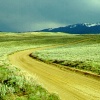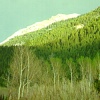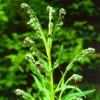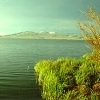Success stories: Tales of improving our native biodiversity
from Becoming Big - Centennial Valley, Montana
Mandy Tu/GIST
July 2002
Photographs
Click
on the images below to view photographs related
to this success story.

|

|

|

|

|
The Setting
Centennial Valley is a high-elevation montane valley that supports
diverse sagebrush, grassland, and forest communities, and is interspersed
with intact riparian swathes and large wetland-marsh complexes. It is
located in the far southwest corner of Montana, a mere 80 km (50 mi)
from Yellowstone National Park. Today, Centennial Valley's wetlands and
rangelands remain remote and undeveloped. As such, Centennial Valley provides
essential habitat for more than 230 bird species (including trumpeter swans,
sandhill cranes, and peregrine falcons), mammals such as pronghorn, badgers,
wolverines, grizzly bears, and gray wolves, native fish such as arctic
grayling and westslope cutthroat trout, and several regionally rare plant
species. In addition, this valley functions as a vital migration corridor
between the Greater Yellowstone Ecosystem and the Northern Rocky Mountains
for large mammals.
The Threat - Invasive Non-Native Species
Remote and largely intact, the Centennial Valley currently has few
infestations of invasive weeds. Large populations of these
habitat-transforming non-natives occur nearby however, and when they spread into
and establish in native habitats, these undesirables can readily outcompete
and displace the native plants that the rest of the ecosystem is built
upon. Unfortunately, small populations of several species of invasive
weeds are already present in the Valley, including: houndstongue
(Cynoglossum officinale), Russian knapweed (Centaurea repens),
and dyer's woad (Isatis tinctoria). Very small, isolated
populations of Canada thistle (Cirsium arvense) and bull thistle
(Cirsium vulgare) are also present in the Valley. Especially
troubling are the large populations of spotted knapweed (Centaurea
maculosa) that occur to the west and north of the valley. These
invaders have the capability of completely transforming the biologically
diverse grasslands into single-species stands of non-native weeds that
provide little native food or habitat for grazing animals or native
wildlife. They could also alter the hydrology and change nutrient
cycling within the valley if allowed to invade and take over. The native
biodiversity of the Centennial Valley was clearly threatened by the
encroachment of these non-native pests.
Fortunately, a small group of people realized that now is the time to begin working cooperatively to prevent this currently small problem from spreading and becoming a big problem.
A Success Story
Alarmed by the approaching front of invasive non-native plants, two
interns for The Nature Conservancy - Kelly Pohl and Bryan Gartland -
set about generating a cooperative approach between the public agencies,
private landowners, and other land-managers to combat weeds in Centennial
Valley, while the weed infestations were still small and manageable. In
1999, they were instrumental in starting the "Red Rock Watershed Weed
Project" (RRWWP), with the initial goal of inspiring and helping private
landowners of the lower (western) Centennial Valley and the area around
the town of Lima, MT to carry out noxious weed control. The RRWWP includes
representatives from The Nature Conservancy, Beaverhead County, the U.S.
Fish and Wildlife Service Partners for Fish and Wildlife program, the
Red Rock Lakes National Wildlife Refuge, the Bureau of Land Management,
the Greater Yellowstone Coalition, the Montana Audubon Society, the Rocky
Mountain Elk Foundation, and local landowners. The goals of the RRWWP
were further refined to:
1. Involve as many landowners within the Valley as possible,
2. Control weeds by treating at least 2,500 acres within the project area,
3. Survey and map as much of the project area (for weeds) as possible, and
4. Provide educational resources for landowners and visitors to the project
area.
The RRWWP secured nearly $26,000 in grant funding from the Montana Noxious Weed Trust Fund and the Rocky Mountain Elk Foundation, and matching funds were acquired from each of the cooperators. These funds were used for educational materials and to provide a 50% cost-share for herbicide and commercial herbicide application expenses for each of the landowners.
Early in that first year (1999), the two TNC interns contacted local landowners and invited them to join the group. Weed identification booklets and literature were created and distributed, and agreements between all partners were decided upon. The RRWWP now has many participants, and they agree that having interns on the ground to contact landowners and ensure that resources for implementing the project were properly distributed was, and continues to be, crucial to the project's success.
In 1999, 25 of the 34 landowners within the 400,000-acre project area committed to the program (representing 88% of the project area). A total of 2,091 acres of weeds were treated that first year, and 10,000 acres were surveyed for weeds and any infestations mapped. Additionally, brochures, pamphlets and other materials with information on how to prevent the spread of noxious weeds, with details about the ecology of specific species, proper herbicide use, and integrated weed management techniques, were distributed to landowners, tourists, and sportsmen's associations in the southwestern portion of the state.
The RRWWP is far from finished in its work and sustained vigilance will be required to protect the Centennial Valley from non-native species invasion. The participants know that it is imperative that this cooperative project continues into the future. The RRWWP is scheduled to continue for four years (from 1999 to 2003), and they plan to expand the border of the project area.
Current Status
As of early 2002, the RRWWP has now expanded to include the entire Red
Rock River watershed as well as the nearby Big Hole River watershed, and
encompasses a total area of greater than 1 million acres. Ten interns
will be deployed in these watersheds during 2002 to sign-up landowners
into weed management districts, coordinate weed management actions between
the county and landowners, provide outreach and education, and help with
community weed management events (e.g., Weed Days). When landowners in
the Big Hole River watershed first approached Beaverhead County about
forming a weed management district, the county commissioner told them that
if they tried to form a weed management district without TNC, it would be
a failure.
This project demonstrates that because rapid action was taken before the weed populations became insurmountable infestations, and with the active collaboration from all stakeholders, that large, pristine areas such as Montana's Centennial Valley can be protected for future generations from encroaching invasive weeds. The coordination of the RRWWP by TNC interns strengthened TNC's ties with the local communities, and gives the organization much greater credibility as a steward of the land and a trustworthy source of information and advice about land management. Because non-native species invasions threaten ranching, recreational uses and native biological diversity in the surrounding region, word has gotten out that TNC is a reliable, hard-working, perhaps even essential partner in the business of combating this shared threat. The strong relationships built in these efforts have, in turn, created more opportunities for conservation in the region.
Red Rock Watershed Weed Project (RRWWP) Partners
Private landowners, ranchers
Beaverhead County
Bureau of Land Management, the Greater Yellowstone Coalition
Montana Audubon Society
Red Rock Lakes National Wildlife Refuge
Rocky Mountain Elk Foundation
The Nature Conservancy
U.S. Fish and Wildlife Service Partners for Fish and Wildlife program
Acknowledgements
Brian Martin, TNC's Director of Stewardship & Great Plains Project Manager
in Montana provided information and comments regarding the role of TNC in
the RRWWP.
More Information
For more information, contact The Nature Conservancy's Wildland Invasive
Species Team at Phone: 530-754-8891 or E-mail: bamrice(at)ucdavis.edu.
Review articles with more detailed information about some of these species can be obtained from the TNC Wildland Invasive Species Team web site.
This document in other formats: MS Word, Adobe Acrobat
This article may be treated as a press release and may be quoted by the media in part or in full. Publication quality versions of images on this page can be obtained from the Wildland Invasive Species Team by sending email to bamrice(at)ucdavis.edu.


